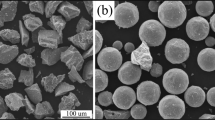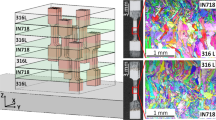Abstract
Laser melt injection (LMI) is a promising technology to produce ceramic particles reinforced metal matrix composites (MMCs) to achieve surface modification and performance upgrading. In this paper, the LMI process was conducted on a Ti6Al4V substrate with ZrO2 particles (ZrO2p) to produce a functionally graded material. Subsequently, a novel finite element model, at both macro and micro scales, was proposed to calculate the thermal–mechanical characteristics during the LMI process to expound on the crack formation mechanism. The differences in experiments, including track dimensions, particle distribution, and crack morphology of the MMC layer, were analyzed, corresponding to varied laser power and scanning velocity. The three-dimensional macro-simulated results showed alternating tensile-compressive residual stresses spread over the heat-affected zone. Besides, the most significant longitudinal tensile stress, the peak values exceeding the yield strength of Ti6Al4V, was distributed on the MMC top surface, leading to cracks. The two-dimensional micro-scale models revealed the residual stress distributed remarkably uniformly in the ZrO2 particles, and the stress values were more significant than those of the Ti6Al4V substrate. Furthermore, there were stress concentration points on the surfaces of ZrO2p, which were the sources of micro-fissure. At the same time, the gaps caused between the Ti6Al4V matrix and the ZrO2p surface also provided the conditions for the formation of microcracks. More conspicuous cracks would be generated after lots of microcracks were gathered.



source model for LMI simulation













Similar content being viewed by others
References
Cooper KP, Slebodnick P (1989) Recent developments in laser melt/particle injection processing. J Laser Appl 1:21
Chueh Y, Zhang X, Wei C, Sun Z (2020) Additive manufacturing of polymer-metal/ceramic functionally graded composite components via multiple material laser powder bed fusion. J Manuf Sci Eng 142:051003
Hiraga H, Inoue T, Kamado S, Kojima Y (2001) Improving the wear resistance of a magnesium alloy by laser melt injection. Mater Trans 42:1322–1325
Ocelik V, Vreeling JA, De Hosson JTM (2001) EBSP study of reaction zone in SiC/Al metal matrix composite prepared by laser melt injection. J Mater Sci 36:4845–4849
Cabeza M, Castro G, Merino P, Pena G, Roman M (2014) A study of laser melt injection of TiN particles to repair maraging tool steels. Surf Interface Anal 46:861–864
Verezub O, Kálazi Z, Buza G, Verezub NV, Kaptay G (2009) In-situ synthesis of a carbide reinforced steel matrix surface nanocomposite by laser melt injection technology and subsequent heat treatment. Surf Coatings Technol 203:3049–3057
Do Nascimento AM, Ocelík V, Ierardi MCF, De Hosson JTM (2008) Microstructure of reaction zone in WCp/duplex stainless steels matrix composites processing by laser melt injection. Surf Coatings Technol 202:2113–2120
Vreeling JA, Ocelik V, De Hosson JT (2002) Ti-6Al-4V strengthened by laser melt injection of WCp particles. 50:4913–4924
Pei YT, Ocelik V, De Hosson JTM (2002) SiCp/Ti6Al4V functionally graded materials produced by laser melt injection. Acta Mater 50:2035–2051
Vreeling JA (2001) Laser Melt Injection of Ceramic Particles in Metals. 11–12
Ocelik V, De Hosson JTM (2010) Laser melt injection of ceramic particles in metals: processing, microstructure and properties. Int J Microstruct Mater Prop 5:116–163
Li L, Liu D, Chen Y, Wang C, Li F (2009) Electron microscopy study of reaction layers between single-crystal WC particle and Ti – 6Al – 4V after laser melt injection. Acta Mater 57:3606–3614
Zhao L, Jiang Z, Zhang C (2021) Residual stress and fracture toughness of sintered body of ZrO2-GO composite ceramics material. Ceram Int 47:388–392
Liu D, Li F, Chen Y, Li L (2008) WCp/Ti-6Al-4V graded composite layers prepared by laser melt injection. Rare Met Mater Eng 37:1790–1794
Akbari M, Saedodin S, Toghraie D, Shoja-Razavi R, Kowsari F (2014) Experimental and numerical investigation of temperature distribution and melt pool geometry during pulsed laser welding of Ti6Al4V alloy. Opt Laser Technol 59:52–59
Özsunar A (2008) Investigation of temperature distribution in ZrO2 insulation coatings on Ag substrates during cooling. Mater Des 29:1690–1693
Lurie S, Volkov-Bogorodsky D, Leontiev A, Aifantis E (2011) Eshelby’s inclusion problem in the gradient theory of elasticity: Applications to composite materials. Int J Eng Sci 49:1517–1525
Chang WS, Na SJ (2002) A study on the prediction of the laser weld shape with varying heat source equations and the thermal distortion of a small structure in micro-joining. J Mater Process Technol 120:208–214
Goldak J, Chakravarti A, Bibby M (1984) A new finite element model for welding heat sources. Metall Trans B 15:299–305
Freiße H, Bohlen A, Seefeld T (2019) Determination of the particle content in laser melt injected tracks. J Mater Process Technol 267:177–185
Tan W, Bailey NS, Shin YC (2013) Investigation of keyhole plume and molten pool based on a three-dimensional dynamic model with sharp interface formulation. J Phys D Appl Phys 46:055501
Chen J, Ouyang Z, Du X, Wei Y (2022) Weld pool dynamics and joining mechanism in pulse wave laser beam welding of Ti-6Al-4V titanium alloy sheets assembled in butt joint with an air gap. Opt Laser Technol 146:107558
Chongbunwatana K (2014) Simulation of vapour keyhole and weld pool dynamics during laser beam welding. Prod Eng 8:499–511
Acknowledgements
The authors gratefully acknowledged projects funded by China Postdoctoral Science Foundation (No. 2020M671479) and Priority Academic Program Development of Jiangsu Higher Education Institutions (PAPD).
Funding
This work was supported by the China Postdoctoral Science Foundation (No. 2020M671479) and Priority Academic Program Development of Jiangsu Higher Education Institutions (PAPD).
Author information
Authors and Affiliations
Corresponding author
Ethics declarations
Ethics approval
Not applicable.
Consent to participate
The authors declare their consent to participate.
Consent for publication
The authors declare their consent for publication.
Conflict of interest
The authors declare no competing interests.
Additional information
Publisher's Note
Springer Nature remains neutral with regard to jurisdictional claims in published maps and institutional affiliations.
Rights and permissions
About this article
Cite this article
Ouyang, Z., Jin, H., Cheng, Q. et al. Macro–micro residual stress prediction and hot crack formation mechanism during laser melt injection processing of ZrO2 particles into Ti6Al4V substrate. Int J Adv Manuf Technol 121, 3637–3651 (2022). https://doi.org/10.1007/s00170-022-09561-x
Received:
Accepted:
Published:
Issue Date:
DOI: https://doi.org/10.1007/s00170-022-09561-x




